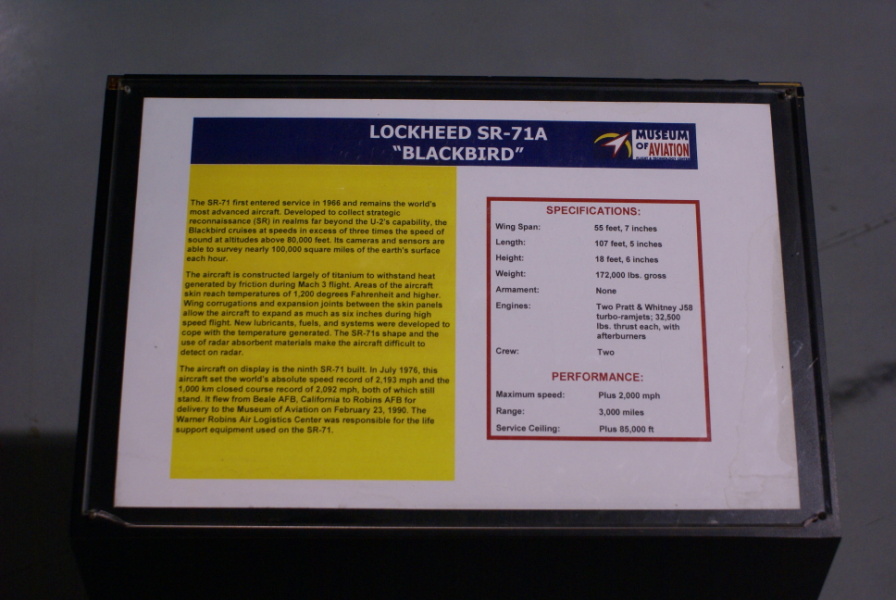| Prev |
heroicrelics.org Museum of Aviation Site Index SR-71 Gallery |
Next |
dsc64160.jpg
The sign accompanying the SR-71.
It reads
Lockheed SR-71A
"Blackbird"The SR-71 first entered service in 1966 and remains the world's most advanced aircraft. Developed to collect strategic reconnaissance (SR) in realms far beyond the U-2's capability, the Blackbird cruises at speeds in excess of three times the speed of sound at altitudes above 80,000 feet. Its cameras and sensors are able to survey nearly 100,000 square miles of the earth's surface each hour.
The aircraft is constructed largely of titanium to withstand heat generated by friction during Mach 3 flight. Areas of the aircraft skin reach temperatures of 1,200 degrees Fahrenheit and higher. Wing corrugations and expansion joints between the skin panels allow the aircraft to expand as much as six inches during high speed flight. New lubricants, fuels, and systems were developed to cope with the temperature generated. The SR-71's shape and the use of radar absorbent materials make the aircraft difficult to detect on radar.
The aircraft on display is the ninth SR-71 built. In July 1976, this aircraft set the world's absolute speed record of 2,193 mph and the 1,000 km closed course record of 2,092 mph, both of which still stand. It flew from Beale AFB, California to Robins AFB for deliver to the Museum of Aviation on February 23, 1990. The Warner Robins Air Logistics Center was responsible for the life support equipment used on the SR-71.
Specifications: Wing Span: 55 feet, 7 inches Length: 107 feet, 5 inches Height: 18 feet, 6 inches Weight: 172,000 lbs. gross Armament: None Engines: Two Pratt & Whitney J58 turbo-ramjets; 32,500 lbs. thrust each, with afterburners Crew: Two Performance: Maximum speed: Plus 2,000 mph Range: 3,000 miles Service Ceiling: Plus 85,000 ft

| Time picture taken | Sun Jun 21 11:59:54 2009 |
| Location picture taken |
Century of Flight (Hangar 2) Museum of Aviation Warner Robins, Georgia |
| Prev |
heroicrelics.org Museum of Aviation Site Index SR-71 Gallery |
Next |